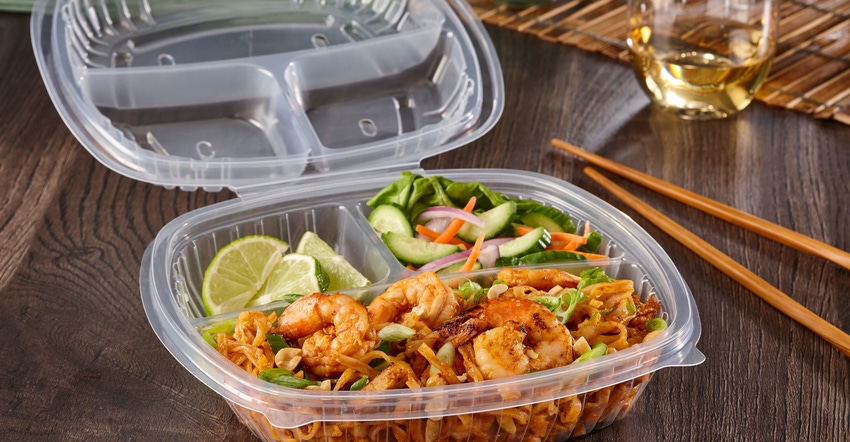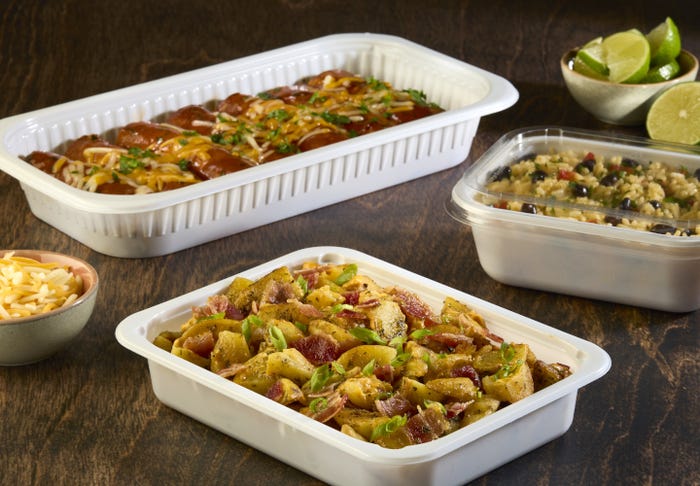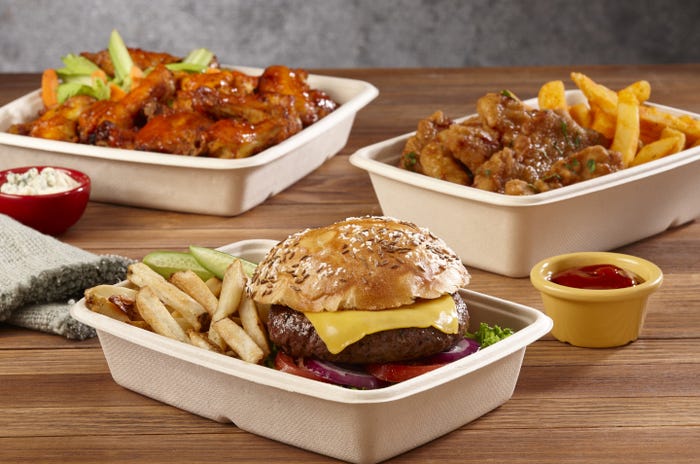How Packaging Has Transformed How Americans Eat
Over the last 40 years, packaging innovations have vaulted the TV dinner beyond a convenient way to heat up foods.

When it comes to how Americans consume food, a lot has changed over the past few decades. In 1983, we were on the precipice of a transformation of American eating habits. People wanted ways to get food (specifically dinners) quicker than ever. The increase in the number of dual-income households as more and more women and working moms entered the workforce meant that single people, couples, and families alike were looking for faster ways to get dinner on the table. What many of us called “speedy suppers” were shifting how we ate every night. People were looking for more convenience in the kitchen, and frozen meals were exploding in popularity at grocery stores nationwide.
At the same time, we also witnessed a growing interest in international cuisines and “gourmet flavors.” Pates, cheeses beyond cheddar, breads, jellies, baked goods, and more were entering supermarket chains. According to the Los Angeles Times, imported foods saw a 20% growth in the 1980s. No longer were pizza and hamburgers the only options. Our tastes and willingness to experiment with foods were changing; for restaurants, caterers, and the daring eater alike, that was all exciting news.
As we celebrate 40 years of innovation, it’s important to reflect on how food packaging has enabled operators to adapt to consumers’ ever-evolving eating preferences, adapt to sustainable lifestyle changes, and continue enhancing dining experiences for decades to come.
Takeout, prepared foods and on-the-go packaging for an even faster American family.
In 1986, the first microwave-safe packaging trays were being marketed, and shortly after that, anything that could be made microwavable was being made microwavable. Frozen dinners that needed to be popped in the oven were now heated with microwave-safe packaging. Pizzas, breakfast, side dishes, popcorn, and more were being made microwave safe. This shift revolutionized the American dining experience allowing us to dine on quickly prepared meals more easily as we watched our favorite shows.
If we thought we were going fast back in the 80s, we’d be blown away by how quickly Americans are moving today. While TV dinners are still around, the global pandemic accelerated the demand for prepared foods, takeout, delivery, and grab n’ go. The convenience culture shows no signs of slowing down. The NPD Group predicts that retail ready-to-eat foods will grow by double-digits through 2024. Research also estimates that delivery sales could rise an annual average of more than 20% to $365 billion worldwide by 2030, from $35 billion.

Eating in a hurry today is like nothing we’ve seen before — all enabled by innovations in food packaging. With customizable and sustainable options and packaging tailored for hot foods vs. cold foods and liquids vs. solids, operators can deliver food and offer takeout that looks as good once it’s home as it does in the restaurant. Fast-casual restaurants, coffee shops, and even food trucks provide delicious food options using more durable packaging that maintains temperature, moisture, and freshness well after it leaves the establishment. Even gas stations and convenience store chains can now provide grab-and-go and made-to-order foods that taste as good as they look through safely sealed packaging.
Access to new tastes and dining preferences.
Getting a croissant today may not be as exciting as in the 1980s, but that’s a positive thing. American tastes have changed dramatically over the past 40 years, with more people willing to try foods. As the gourmet foods trend became more mainstream, the foodservice industry had a significant opportunity to cater to the new “cosmopolitan palates” by elevating the food and dining experience. It began offering new catering options to help bring more high-end meals to events, which typically served food in only aluminum containers. Making the food look more appealing and sophisticated added an exciting dimension to serving gourmet foods.
Now Millennials are driving an even more increased desire for authentic global cuisines and operators are adapting. Whether it’s a new restaurant concept or dietary needs, consumers have easier access to more flavors than ever. Social media is also inspiring demand for food not just to taste good but look good too. Today’s generations of experimental and social media-savvy eaters have new foods at their fingertips as delivery services, online ordering, and the need for convenience are top of mind. This shift gives operators new potential revenue streams and increases the need for food packaging suitable for multiple food applications and to help items look photo-worthy.

Packaging’s path forward.
As we look at the current food packaging industry landscape, a pressing dilemma is emerging as operators seek to embrace sustainability while treading cautiously around the cost implications. Recycled materials that offer comparable performance to less eco-friendly materials often come at a higher cost. This financial barrier can dissuade operators from fully committing to sustainable packaging, resulting in a balancing act between environmental responsibility and fiscal feasibility.
Additionally, there is a lack of a cohesive and unified sustainability mindset across the industry, which results in confusion, hampers progress, and slows down the industry’s overall shift towards developing and adopting sustainable packaging options.
Despite these challenges, many opportunities exist. As environmental and legislative measures take center stage, the packaging industry can focus on aligning its practices with evolving consumer and regulatory demands. Given the heightened interest in sustainable packaging, we may witness a surge in investments and materials innovations to strike a balance between sustainability and cost. Not only does this present an exciting opportunity to propel the industry to a more sustainable future, but it can also create a more positive consumer perception of the benefits of food packaging.
Clearly, a lot has changed in America’s relationship with food in the last 40 years. Whether changing tastes, global trends, economics and technology breakthroughs, and the importance of sustainability, food remains at the center of our lives. From the dinner table to the workplace, people have so many new ways to enjoy the food they eat, and they expect the experience to be the best it can be. Our purpose remains clear as we look to the future: we must continue reinventing food packaging to nourish and protect our world.
Albert Salama is the visionary founder and CEO of Sabert Corp., a global leader in innovative and sustainable food packaging solutions. Salama founded Sabert in 1983 with minimal capital and a product line consisting of just five items. Today, Sabert manufactures more than 1,000 stock-keeping units (SKUs) used by leading international, national, and local food retailers, including restaurant chains, supermarkets, food processors, foodservice distribution, and more. Previously, Salama has been recognized with the 2014 Ernst & Young Entrepreneur of the Year Award in the New Jersey region, the 2018 Ellis Island Medal of Honor, and was honored with the 2022 Corporate Lifetime Achievement Award from the Association for Corporate Growth (ACG) of New Jersey. As founder and CEO of Sabert, he leads the organization with his unique entrepreneurial spirit, driving the organization’s strategic vision and combining organic growth opportunities and acquisitions to leverage market trends and unmet market needs.
About the Author(s)
You May Also Like


